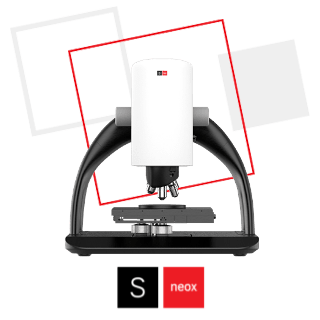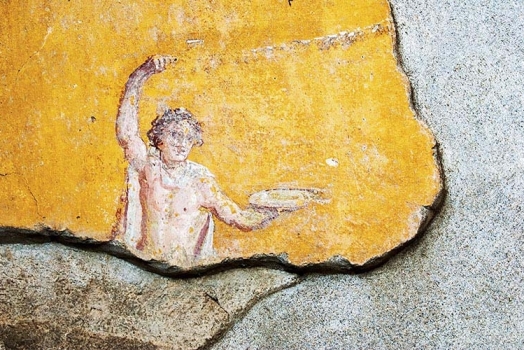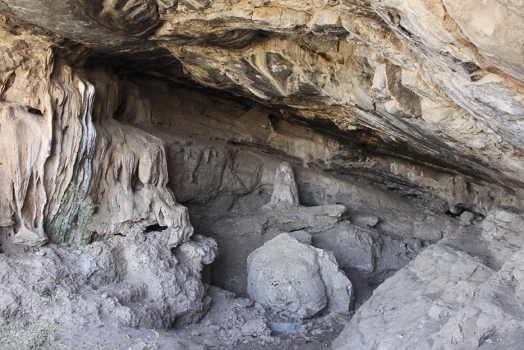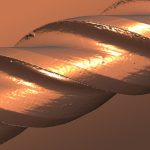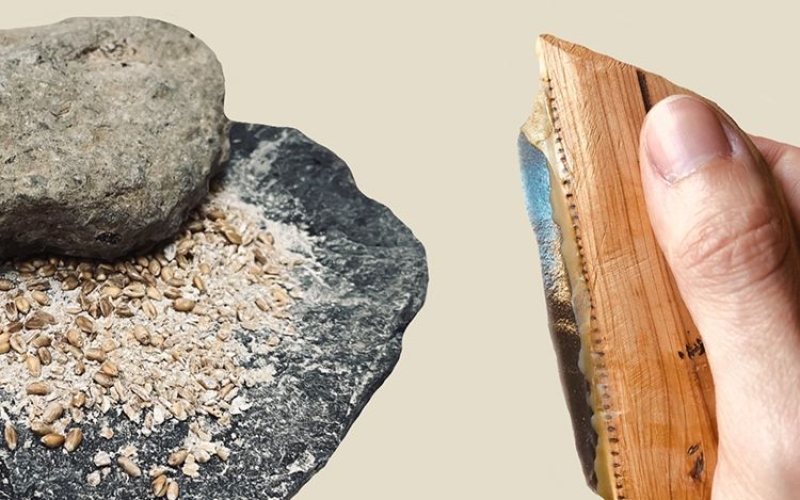
Analyse der Werkzeuge der ersten neolithischen Bauern

Fiona Pichon und Andrea Zupancich
Die IMF (Institució Milà i Fontanals) gehört zum Spanischen Nationalen Forschungsrat (CSIC) und wurde 1968 gegründet. Heute konzentriert sich das IMF auf Forschung in fünf Bereichen der Geisteswissenschaften: Anthropologie, Archäologie, Mediävistik, Wissenschaftsgeschichte und Musikwissenschaft.
Durch die Untersuchung mikroskopischer Nutzungsspuren können wir die Materialien identifizieren, mit denen die Werkzeuge in Kontakt kamen, ihre Verwendung nachvollziehen und den Zustand bestimmen, in dem diese Materialien bearbeitet wurden.”
Die Erforschung, wie sich Werkzeugtechnologien an wechselnde Umwelt- und gesellschaftliche Anforderungen angepasst haben, gehört zu den wirkungsvollsten Methoden, um das Verhalten und die Wirtschaftsweisen früher Gesellschaften zu verstehen.
Steinwerkzeuge stellen dabei einen entscheidenden Beleg dar, da ihre Oberflächen mikroskopische Nutzungsspuren bewahren, die mit ihrem Gebrauch in Verbindung stehen. Diese Abnutzungsspuren, insbesondere die unter Hochleistungsmikroskopen sichtbaren Mikro-Polierungen, zeigen, mit welchen Materialien – Pflanzen, Tieren oder Mineralien – die Werkzeuge verwendet wurden, wie sie eingesetzt wurden und in welchem Zustand die Materialien bearbeitet wurden (z. B. trocken, feucht usw.). Diese Analysen liefern wertvolle Einblicke in den Alltag, die Technologien und die Umwelten prähistorischer Gemeinschaften.
In den letzten zehn Jahren hat sich die Texturanalyse von 3D-Topografien, die mit Konfokalmikroskopen aufgenommen wurden, zunehmend als Methode zur Untersuchung der Funktion antiker Steinwerkzeuge etabliert. Dies bietet eine hochpräzise Möglichkeit, Nutzungsspuren quantifizierbar zu machen.
Dieser Ansatz hat vielversprechende Ergebnisse bei der Charakterisierung von Politur auf experimentellen und archäologischen Steinwerkzeugen geliefert und einzigartige Einblicke in das Verhalten der Menschen in vorgeschichtlicher Zeit ermöglicht. Besonders bedeutsam war dies für die Bestimmung, wie, wann und wo Getreide im Nahen Osten vor etwa 11.000 Jahren domestiziert wurde.
In unserer Forschung kombinieren wir klassische archäologische Methoden mit fortschrittlicher Oberflächenanalytik, um zu rekonstruieren, wie neolithische Gemeinschaften in Südwestasien Pflanzen nutzten – insbesondere bei der Nahrungsbeschaffung (z. B. Getreideernte) und Verarbeitung (z. B. Mahlen von Getreide und Hülsenfrüchten) sowie beim Herstellen von Gegenständen (z. B. Bearbeitung von Tierhäuten) und anderen Tätigkeiten. Zum ersten Mal wendeten wir quantitative Analysen sowohl auf Mahlsteine als auch auf Obsidianwerkzeuge an, wobei wir das 3D-Optikprofilometer PLu neox nutzten.
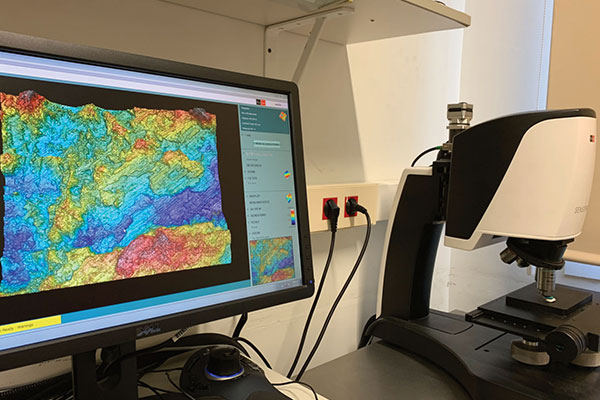
Dieser Ansatz ermöglicht es uns, Abnutzungsspuren zu unterscheiden, die durch verschiedene Kontaktmaterialien und Bewegungsabläufe entstehen, und stärkt so unsere Interpretationen, während er zugleich die Wiederholbarkeit und Reproduzierbarkeit unserer Ergebnisse verbessert – Schlüsselaspekte für verlässliche archäologische Forschung.
In zwei kürzlich veröffentlichten Studien konzentrierten wir uns auf die Analyse von abgeschlagenen Obsidianwerkzeugen und geschliffenen Steinwerkzeugen. Einerseits waren Obsidianwerkzeuge in der Antike aufgrund ihrer Schärfe und Brillanz hochgeschätzt und wurden in Südwestasien über Hunderte oder sogar Tausende von Kilometern, oft aus anatolischen Lagerstätten, transportiert. Ihr Handel spiegelt die Entwicklung komplexerer sozioökonomischer Systeme und sozialer Netzwerke im Neolithikum wider.
Durch die Untersuchung von Nutzungsspuren an diesen Werkzeugen wollen wir ihre Funktion besser verstehen und die Hintergründe des weiten Obsidianhandels in prähistorischen Gesellschaften beleuchten. Unsere Studie stellt den ersten Versuch dar, das Potenzial der Konfokalmikroskopie und der 3D-Texturanalyse zu nutzen, um Nutzungsspuren an Obsidianwerkzeugen quantitativ zu unterscheiden und so die Grenzen konventioneller optischer Methoden zu überwinden. Kontrollierte Schneid- und Schabeexperimente wurden durchgeführt, um die Methode an unterschiedlichen bearbeiteten Materialien zu testen.
Mit diesem gezielten experimentellen Programm konnten wir eine Referenzdatenbank mit Oberflächenrauheits-Texturen für unbenutzten und verwendeten Obsidian erstellen, wobei Materialien wie Tierhaut, Pflanzenfasern und Mineralien untersucht wurden, die in Längs- und Querbewegungen bearbeitet wurden. Die Ergebnisse bestätigen, dass die Konfokaltechnologie eine außergewöhnliche Präzision bei der Identifizierung von Nutzungsspuren bietet und Materialien unterscheidet, die mit herkömmlichen Methoden schwer zu differenzieren sind, da sich ähnliche Spuren bilden können (Equifinalität). Diese Methode verbessert die Spurenerkennung durch einen standardisierten, wiederholbaren und reproduzierbaren Ansatz, der die mikroskopische Oberflächenrauheit präzise misst.
Geschliffene Steinwerkzeuge liefern zentrale Hinweise auf das Verhalten im Zusammenhang mit der Nutzung und Verarbeitung von Pflanzen. Durch die Analyse ihrer Funktion anhand von Nutzungsspuren können wir rekonstruieren, wie frühe Bauern verschiedene pflanzliche Nahrungsmittel wie Getreide, Hülsenfrüchte, Knollen und Früchte verarbeitet haben und welche Techniken und Bewegungsabläufe dabei zum Einsatz kamen. Die Untersuchung dieser Werkzeuge ermöglicht es uns, alte Ernährungspraktiken nachzuvollziehen und die sich entwickelnde Beziehung zwischen Mensch und Pflanze zu verstehen.
Unsere aktuelle Studie untersuchte das Potenzial der Konfokalmikroskopie und der 3D-Oberflächentexturanalyse zur Untersuchung von geschliffenen Steinwerkzeugen. Ziel war es, die qualitativen Informationen aus der optischen Mikroskopie mit den quantitativen Daten aus 3D-Konfokalaufnahmen zu kombinieren.
Dazu entwickelten wir ein speziell angepasstes experimentelles Programm, bei dem eine Reihe moderner Repliken geschliffener Steinwerkzeuge verwendet wurde, um verschiedene Getreide- und Hülsenfrüchte zu verarbeiten. Anschließend erstellten wir 3D-Aufnahmen der Mikro-Polierungen, die von jeder Pflanzenart erzeugt wurden, und extrahierten Texturparameter, die statistisch ausgewertet wurden. Diese Analysen zeigten das Potenzial dieser Methode, unterschiedliche Arten der Pflanzenverarbeitung und -nutzung zu unterscheiden.
MESSUNGEN
Topografische Aufnahmen (Abbildung 2) wurden mit einem Sensofar PLu neox aufgenommen, ausgestattet mit 20X- und 50X-Objektiven im Hellfeldmodus. Die Konfokaltechnologie wurde eingesetzt, um Oberflächenveränderungen an Steinwerkzeugen zu untersuchen. Insbesondere kam die Texturanalyse zum Einsatz, um Nutzungsspuren an Obsidianwerkzeugen und geschliffenen Steinwerkzeugen quantitativ zu unterscheiden.
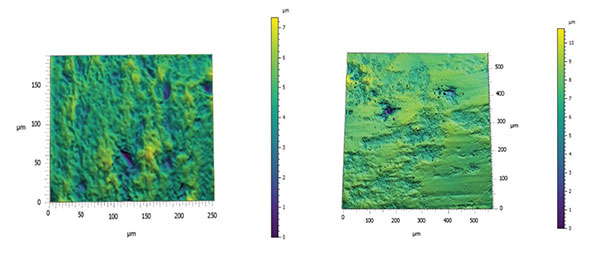
Die in unserer Forschung vorgestellten Schlussfolgerungen und Methodiken wurden erfolgreich mit dem 3D-Optikprofilometer PLu neox umgesetzt, das hochauflösende Bildgebung und Oberflächenmesstechnik an Steinwerkzeugen ermöglicht. Der PLu neox, der im Konfokalmodus betrieben wird, erweist sich als äußerst nützliches, präzises, schnelles und nicht-invasives Werkzeug zur Analyse archäologischer Werkzeuge. Diese Technologie erlaubt die Erfassung relevanter Daten über die Art und Eigenschaften der Oberflächenabnutzungsprozesse, die archäologische Materialien betreffen.
Die unterschiedlichen Oberflächentopografien, die mit dem 3D-Profilometer gewonnen wurden, liefern wertvolle Einblicke in den Einsatz von geschliffenen Stein- und Obsidianwerkzeugen. Diese Beobachtungen helfen uns, Ernährungspraktiken und die Entwicklung der Beziehung zwischen Mensch und Pflanze im Laufe der Zeit besser zu verstehen sowie die Entstehung komplexerer sozioökonomischer Systeme und sozialer Netzwerke nachzuvollziehen.
Insgesamt bestätigen die Ergebnisse, dass die Konfokaltechnologie – insbesondere mit dem von Sensofar entwickelten PLu neox-System – eine außergewöhnliche Präzision bei der Identifizierung und Quantifizierung von Nutzungsspuren bietet. Dieser Ansatz eröffnet neue Perspektiven für das Verständnis der Werkzeugfunktionen und der Materialbearbeitung in der Urgeschichte und zeigt beispielhaft, wie moderne Oberflächenmesstechnik das Verhalten und die Ernährungsgewohnheiten alter Gesellschaften auf bislang unerreichte Weise sichtbar machen kann – eine Brücke zwischen Wissenschaft und Geschichte.
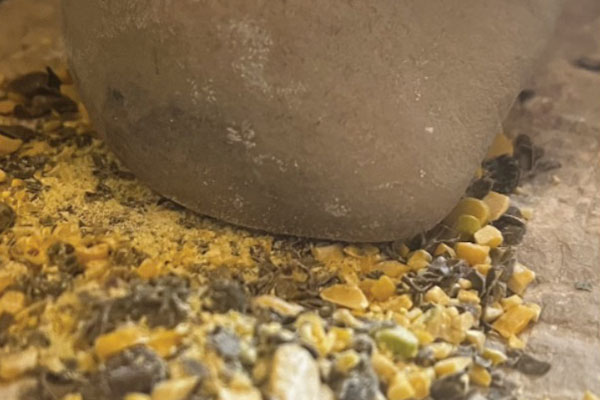
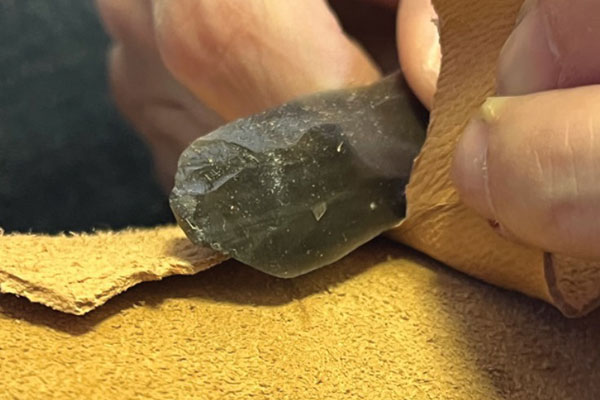
Referenzen
[1] Pichon, F., Ibàñez Estevez, J. J., Astruc, L., Gassin, B., Rodrìguez Rodrìguez, A., & Lugliè, C. (2025). Shining light on dark matter: Advancing functional analysis of obsidian tools with confocal scanning microscopy. Journal of archaeological method and theory, 32(1).
[2] Zupancich, A., Cristiani, E., Di Fazio, M., Medeghini, L., Gopher, A., & Ibàñez, J. J. (2025). Beyond the surface: Exploring ancient plant food processing through confocal microscopy and 3D texture analysis on ground stone tools. Journal of archaeological method and theory, 32(1), 1-34.



